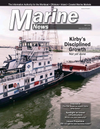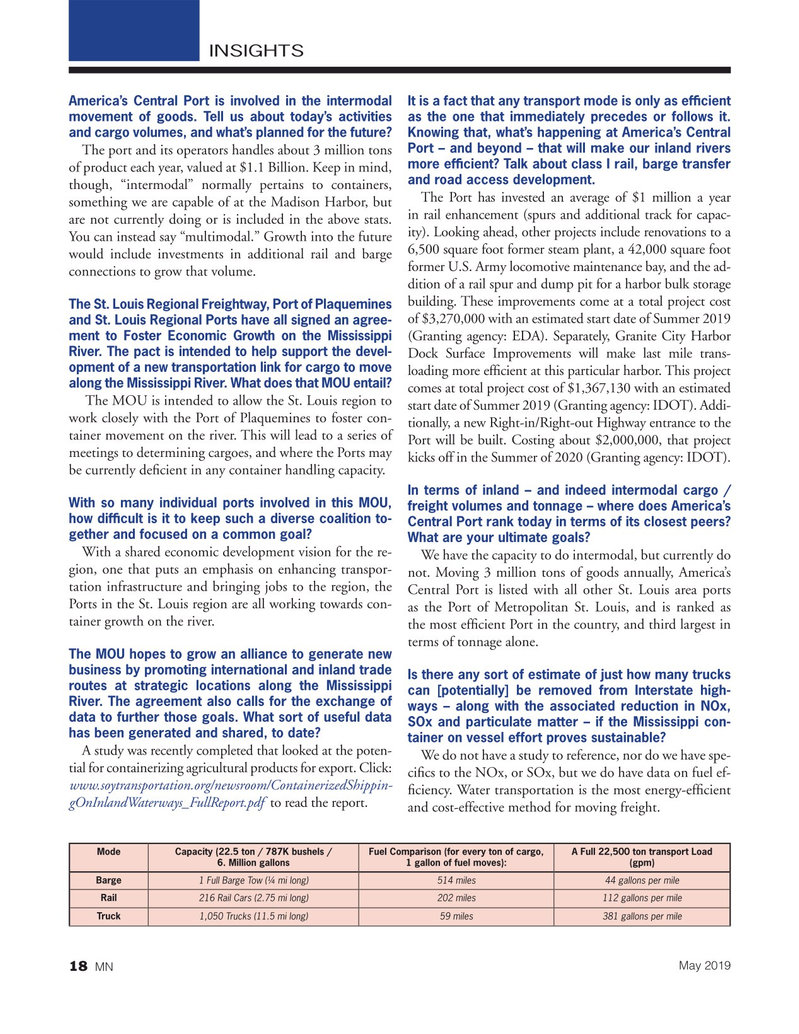
Page 18: of Marine News Magazine (May 2019)
Inland Waterways
Read this page in Pdf, Flash or Html5 edition of May 2019 Marine News Magazine
INSIGHTS
America’s Central Port is involved in the intermodal It is a fact that any transport mode is only as ef? cient movement of goods. Tell us about today’s activities as the one that immediately precedes or follows it. and cargo volumes, and what’s planned for the future? Knowing that, what’s happening at America’s Central
Port – and beyond – that will make our inland rivers
The port and its operators handles about 3 million tons more ef? cient? Talk about class I rail, barge transfer of product each year, valued at $1.1 Billion. Keep in mind, and road access development.
though, “intermodal” normally pertains to containers,
The Port has invested an average of $1 million a year something we are capable of at the Madison Harbor, but are not currently doing or is included in the above stats. in rail enhancement (spurs and additional track for capac-
You can instead say “multimodal.” Growth into the future ity). Looking ahead, other projects include renovations to a would include investments in additional rail and barge 6,500 square foot former steam plant, a 42,000 square foot former U.S. Army locomotive maintenance bay, and the ad- connections to grow that volume.
dition of a rail spur and dump pit for a harbor bulk storage building. These improvements come at a total project cost
The St. Louis Regional Freightway, Port of Plaquemines of $3,270,000 with an estimated start date of Summer 2019 and St. Louis Regional Ports have all signed an agree- ment to Foster Economic Growth on the Mississippi (Granting agency: EDA). Separately, Granite City Harbor
River. The pact is intended to help support the devel-
Dock Surface Improvements will make last mile trans- opment of a new transportation link for cargo to move loading more ef? cient at this particular harbor. This project along the Mississippi River. What does that MOU entail?
comes at total project cost of $1,367,130 with an estimated The MOU is intended to allow the St. Louis region to start date of Summer 2019 (Granting agency: IDOT). Addi- work closely with the Port of Plaquemines to foster con- tionally, a new Right-in/Right-out Highway entrance to the tainer movement on the river. This will lead to a series of Port will be built. Costing about $2,000,000, that project meetings to determining cargoes, and where the Ports may kicks off in the Summer of 2020 (Granting agency: IDOT).
be currently de? cient in any container handling capacity.
In terms of inland – and indeed intermodal cargo /
With so many individual ports involved in this MOU, freight volumes and tonnage – where does America’s how dif? cult is it to keep such a diverse coalition to-
Central Port rank today in terms of its closest peers? gether and focused on a common goal?
What are your ultimate goals?
With a shared economic development vision for the re-
We have the capacity to do intermodal, but currently do gion, one that puts an emphasis on enhancing transpor- not. Moving 3 million tons of goods annually, America’s tation infrastructure and bringing jobs to the region, the Central Port is listed with all other St. Louis area ports
Ports in the St. Louis region are all working towards con- as the Port of Metropolitan St. Louis, and is ranked as tainer growth on the river.
the most ef? cient Port in the country, and third largest in terms of tonnage alone.
The MOU hopes to grow an alliance to generate new business by promoting international and inland trade Is there any sort of estimate of just how many trucks routes at strategic locations along the Mississippi can [potentially] be removed from Interstate high-
River. The agreement also calls for the exchange of ways – along with the associated reduction in NOx, data to further those goals. What sort of useful data SOx and particulate matter – if the Mississippi con- has been generated and shared, to date?
tainer on vessel effort proves sustainable?
A study was recently completed that looked at the poten-
We do not have a study to reference, nor do we have spe- tial for containerizing agricultural products for export. Click: ci? cs to the NOx, or SOx, but we do have data on fuel ef- www.soytransportation.org/newsroom/ContainerizedShippin- ? ciency. Water transportation is the most energy-ef? cient gOnInlandWaterways_FullReport.pdf to read the report.
and cost-effective method for moving freight.
ModeCapacity (22.5 ton / 787K bushels / Fuel Comparison (for every ton of cargo, A Full 22,500 ton transport Load 6. Million gallons 1 gallon of fuel moves): (gpm)
Barge 1 Full Barge Tow (¼ mi long)514 miles44 gallons per mile
Rail 216 Rail Cars (2.75 mi long)202 miles112 gallons per mile
Truck 1,050 Trucks (11.5 mi long)59 miles381 gallons per mile
May 2019 18 MN

 17
17

 19
19
